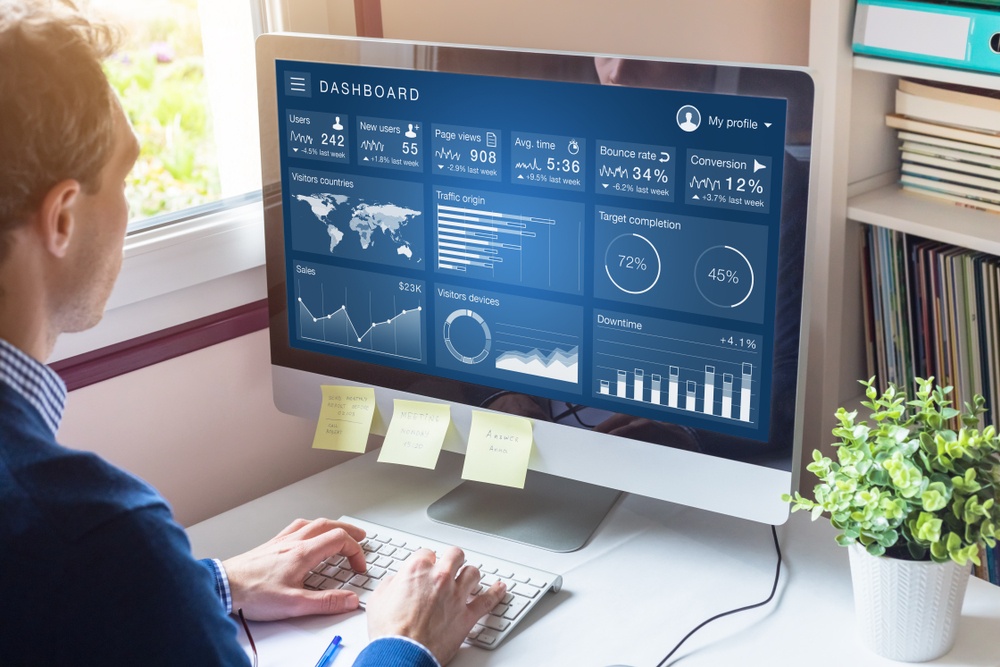
The up-and-coming B2B technology company you work for is growing. Revenue is increasing, and social media followers are skyrocketing. Your marketing efforts are paying off.
At this point, it’s crucial to find and define your key performance indicators (KPIs) and develop a way to track them. There’s a myriad of metrics you can watch, and the sheer volume of data can be overwhelming. To interpret the information and market effectively, you need to be able to connect all the pieces and catch the trends.
What happens when there’s so much to look at that you don’t know where to begin?
A great way to get organized is to create a digital marketing dashboard. A well-developed dashboard allows you to see the most pertinent data at a glance and share it with other top decision makers.
Who will see this, and why?
One of the first things you’ll need to decide is who will see the dashboard you’re creating. Other marketing executives? Sales people? Board members?
The type of data you’ll choose to show on your dashboard can vary depending on the audience and the information that will be most helpful to them. You might be intrigued by social media interactions, for example, while a salesperson could focus more on the number of leads in a sales funnel. Board members might zero in on revenue.
Once you know who will be looking at the data and why it’s important to them, you can create a dashboard that makes their lives so much easier.
Clarify Your Definitions
To be effective, your B2B digital marketing strategy should clarify what the data on your dashboard means. It’s possible that employees from different departments will draw conclusions based on the information displayed.
Confusion, particularly between marketing and sales departments, occurs when clear definitions aren’t set. When you deploy the dashboard, share the definitions with viewers so they understand what they’re seeing.
For example, the term ‘lead conversion’ might not mean the same thing to the sales department that it means to your marketing assistants. What does it mean to a board member? Locking these terms down ensures that you’ll get the most out of your dashboard with the least amount of frustration.
Monitor your Metrics
Choosing which metrics to display goes hand in hand with defining key terms. A dashboard meant to offer an overview of marketing efforts’ performance for board members will be different from one created specifically for marketing employees who focus on creating effective ads.
As you determine the key data points for the dashboard’s purpose, consider how well those metrics reflect your brand narrative. 84 percent of professionals expect content to become more important, with inbound links that build on each other to build the company brand.
Decide how to best show the effectiveness of branding efforts and how responsive the public is to your inbound marketing content. Your best KPIs will have specific targets with a direct relationship to the things that impact your business most, like revenue or generating leads.
Pick your Platform
Some dashboards can be created in Excel. While they’re inexpensive to create, keeping up with the updates can be cumbersome and time consuming. A B2B technology marketing agency might suggest using a software package for creating your digital marketing dashboard. There are a number of dashboard-creating software programs available.
If you have the budget for it, investing in a program like iDashboards, Sisense, Klipfolio or Zoho Reports might save you time and look more professional than something created in Excel. All-in-one programs like HubSpot make a lot of sense, too.
Consider your Time Frame
To make it easy to interpret the data on your dashboard, work with just one time frame--one month, the past six months, the past year, etc. Don’t have one chart cover a single month while the one next to it covers three months. That will make your dashboard too confusing to help anyone.
Create and Insert your Visuals
Sketch a design and get feedback from those who will be looking at the dashboard most. A B2B marketing agency can assist you in designing a dashboard to meet your needs and help you determine which charts and graphs to use.
Use charts and graphs wherever you can so that information can be grasped with just a glance. Along those lines, keep your design simple. Don’t try to pack too much information on there, and think about the devices that the dashboard will be viewed on.
Conclusion
The main purpose of a dashboard is to ease the accessibility of the most important information. Ultimately, it’s about helping people make decisions that will allow your B2B technology company to continue growing.

by Shoham Eckhaus on August 02, 2018
As Chief Strategy Officer at Penguin Shoham leads client strategy and manages an internal team of Inbound Consultants. To get her strategy tuned she starts each morning with Yoga and a big smile :)





